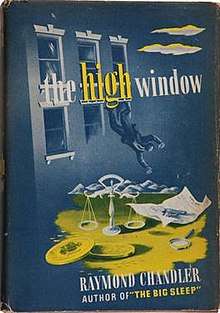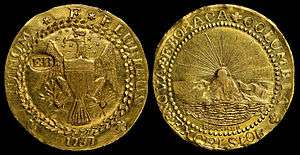The High Window
The High Window is a 1942 novel written by Raymond Chandler. It is his third novel featuring the Los Angeles private detective Philip Marlowe.
 Cover of the first edition | |
| Author | Raymond Chandler |
|---|---|
| Country | United States |
| Language | English |
| Series | Philip Marlowe |
| Genre | Detective, Crime, Novel |
| Publisher | Alfred A. Knopf |
Publication date | 1942 |
| Media type | Print (Hardcover) |
| Pages | 240 pp |
| Preceded by | Farewell, My Lovely |
| Followed by | The Lady in the Lake |
Plot
Private investigator Philip Marlowe is hired by wealthy widow Elizabeth Bright Murdock to recover a missing Brasher Doubloon, a rare and valuable coin. Mrs. Murdock suspects it was stolen by her son's estranged wife, Linda Conquest, a former singer. Returning to his office, Marlowe is followed by a blond man in a coupe. Mrs. Murdock's son Leslie Murdock visits Marlowe and tries to learn why his mother hired him. Murdock reveals that he owes nightclub owner Alex Morny a large sum of money. Marlowe learns that Linda Conquest had two friends: Lois Magic and a Mr. Vannier; Magic is now married to Morny. Marlowe visits Mrs. Morny at home and finds her with Vannier, who acts suspiciously. Marlowe is again tailed by the blond in the coupe and confronts him. He is George Anson Phillips, an amateurish private detective, who wants to enlist Marlowe's help on a case he cannot handle. Marlowe agrees to meet him at his apartment later.
Marlowe visits a rare coin dealer, Mr. Morningstar, who confirms that someone tried to sell him a Brasher Doubloon. Marlowe agrees to buy it back the next day, and after leaving overhears the dealer trying to call Phillips. Marlowe keeps his appointment with Phillips but finds him dead. Police arrest the drunk next door for the murder and give Marlowe an ultimatum to reveal all he knows.
Marlowe receives an unaddressed package containing the coin. He calls Mrs. Murdock but she claims the coin has already been returned to her. Marlowe returns to the coin dealer and finds him dead. Alex Morny's henchman invites Marlowe to visit Morny at his nightclub, where Linda Conquest is singing. Morny demands to know why Marlowe visited his wife, but eventually realizes he is not Marlowe's quarry. Morny offers to hire Marlowe to investigate Vannier, giving him a suspicious receipt for dentistry chemicals that Vannier lost. Marlowe also talks to Linda and decides she is probably not involved in the theft.
Returning to the Murdocks, Marlowe is told a story he doesn’t believe: Leslie Murdock gave the coin to Morny to secure his debts, then changed his mind and retrieved it. Marlowe leaves, beginning to suspect a dark secret involving Merle, the timid family secretary, and Mrs. Murdock's first husband, Horace Bright, who died falling out of a window. The police say the drunk has confessed to the murder of Phillips, but Marlowe discovers he is covering for his landlord and is unlikely to be the real murderer.

Merle arrives at Marlowe's apartment having a nervous breakdown. She claims to have shot Vannier, although her story doesn’t make sense. Marlowe visits Vannier's home, finds him dead, and discovers a photo of a man falling from a window with a woman behind him. Morny and Magic arrive, and Marlowe hides while Morny tricks his wife into leaving her fingerprints on the gun near the body to incriminate her. After they leave Marlowe puts the dead man's prints on the gun instead.
Marlowe visits Mrs. Murdock and reveals what he has figured out: Horace Bright once tried to force himself on Merle, and she either pushed him or allowed him to fall out of a window to his death. Vannier knew and was blackmailing the family. Mrs. Murdock admits it is true and says she regrets ever hiring Marlowe. Marlowe confronts Leslie Murdock, revealing that he knew Murdock and Vannier had a plot to duplicate the coin using dental technology. They had Lois Magic hire Phillips to sell the fakes, but Phillips was frightened by the assignment and mailed the coin to Marlowe. Vannier killed Phillips and the coin dealer to cover his tracks. Leslie killed Vannier because he threatened to ruin Leslie if their scheme ever got out. Leslie confirms the plot, but Marlowe declines to turn him in. The police discover Vannier's role in the counterfeiting and the murders of Phillips and the coin dealer, but they rule his death a suicide.
Marlowe tells Merle it was Mrs. Murdock who pushed her husband out of the window and then blamed Merle for it. Marlowe drives her cross country, to the home of her parents, safely away from Mrs. Murdock. He watches her and her family as he drives away and says, "I had a funny feeling as I saw the house disappear, as though I had written a poem and it was very good and I had lost it and would never remember it again".[1]
Themes
One of the themes of Chandler's novels that differentiate Phillip Marlowe from his hardboiled colleagues is that in spite of his cynicism, Marlowe exhibits the idealism of a Romantic hero.[2][3] Nowhere is this more evident than in The High Window, in which Marlowe rescues a damsel in distress in the form of Merle. Chandler hints at the theme of Marlowe as a romantic knight in the language he uses in the novel to describe Marlowe, such as "shop-soiled Sir Galahad".[4]
Chandler often wrote about corruption in high places. The "Cassidy Case", which Marlowe relates to Breeze in chapter 15,[5] is actually a retelling of the real-life murder in Los Angeles of Ned Doheny, son of oil tycoon Edward Doheny.[6]
Adaptations
Film
Two film adaptations of the novel have been made:
- Time to Kill (1942), re-written to feature the series character Michael Shayne (played by Lloyd Nolan) directed by Herbert I. Leeds
- The Brasher Doubloon (1947), directed by John Brahm
Radio
Two radio adaptations of the novel have been made, as well:
- 17 October 1977 on BBC Radio 4, adapted by Bill Morrison, directed by John Tydeman, and starring Ed Bishop as Marlowe
- 8 October 2011, also on BBC Radio 4, dramatized by Robin Brooks, directed by Sasha Yevtushenko, and starring Toby Stephens; it is available on CD
References
- Chandler, Raymond (2002-06-11). The High Window: A Novel. Knopf Doubleday Publishing Group. ISBN 9781400030170.
- Gross, Miriam (1978). "Preface". In Gross, Miriam (ed.). The World of Raymond Chandler. New York: A & W Publishers. ISBN 978-0-89479-016-4.
- Newman, Robert. "The Dialectic Aspect of Raymond Chandler's Novels".
- Chandler, Raymond (1976). The High Window. New York: Vintage Books. ISBN 0-394-72141-1.
- Chandler, Raymond (1995). Stories & Early Novels. The Library of America. p. 1071.
- McCartney, Laton (2008). The Teapot Dome Scandal: How Big Oil Bought the Harding White House and Tried to Steal the Country. New York: Random House.
External links
- The High Window at Faded Page (Canada)